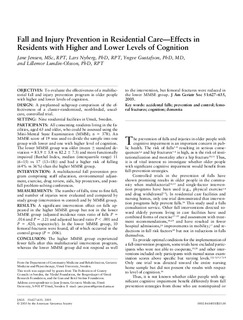| dc.identifier.citation | Jensen, J., Nyberg, L., Gustafson, Y. & Lundin‐Olsson, L. (2003) Fall and Injury Prevention in Residential Care—Effects in Residents with Higher and Lower Levels of Cognition. Journal of the American Geriatrics Society, 51(5), s. 627-635. | |
| dc.description.abstract | To evaluate the effectiveness of a multifactorial fall and injury prevention program in older people with higher and lower levels of cognition. A preplanned subgroup comparison of the effectiveness of a cluster‐randomized, nonblinded, usual‐care, controlled trial. Nine residential facilities in Umeå, Sweden. All consenting residents living in the facilities, aged 65 and older, who could be assessed using the Mini‐Mental State Examination (MMSE; n = 378). An MMSE score of 19 was used to divide the sample into one group with lower and one with higher level of cognition. The lower MMSE group was older (mean ± standard deviation = 83.9 ± 5.8 vs 82.2 ± 7.5) and more functionally impaired (Barthel Index, median (interquartile range) 11 (6–15) vs 17 (13–18)) and had a higher risk of falling (64% vs 36%) than the higher MMSE group. A multifactorial fall prevention program comprising staff education, environmental adjustment, exercise, drug review, aids, hip protectors, and postfall problem‐solving conferences. The number of falls, time to first fall, and number of injuries were evaluated and compared by study group (intervention vs control) and by MMSE group. A significant intervention effect on falls appeared in the higher MMSE group but not in the lower MMSE group (adjusted incidence rates ratio of falls = .016 and = .121 and adjusted hazard ratio < .001 and = .420, respectively). In the lower MMSE group, 10 femoral fractures were found, all of which occurred in the control group ( = .006). The higher MMSE group experienced fewer falls after this multifactorial intervention program, whereas the lower MMSE group did not respond as well to the intervention, but femoral fractures were reduced in the lower MMSE group. | |
